
Guide to Software Development Methodologies: Which to Choose in 2025?
Software development process is like a complex machine with countless complicated parts and elements working together for a single goal. How could you even try to wrap your head around its complexities without proper guidance? That’s where software development methodologies come in.
In this article, we’ll take a deep dive into the top 10 software development methodologies that help companies navigate the complexities of software development processes.
Whether you’re a startup aiming for rapid iterations or an established organization seeking streamlined processes, join us as we explore the most popular methodologies and discover which one is the perfect fit for your project.
Contents
- What is a software development methodology?
- Why choosing the right software development methodology is important?
- How to choose the right software development methodology?
- Top ten software development methodologies in 2025
- Agile development methodology
- Scrum software development methodology
- Extreme programming application development
- Lean Development
- DevOps software development methodology
- Prototype development methodology
- Feature-driven development methodology (FDD)
- Waterfall development methodology
- Rapid application development (RAD)
- Spiral development methodology
- Our approach
What is a software development methodology?
Let’s start with the basics. Software development methodology as a whole refers to a structured approach used by software development teams to efficiently plan, execute, and manage the entire software development process.
It provides a systematic set of guidelines, practices, and procedures to ensure that software projects are successfully completed within budget, on time, and with high quality. Just as contractors and engineers in the construction process follow a carefully crafted plan, software application development methodologies provide a solid blueprint for each phase of creating software systems. These methodologies dictate how tasks are organized, responsibilities are assigned, communication is facilitated, and progress is tracked throughout the development lifecycle.
By following software development methodologies, teams can streamline their workflows, improve collaboration, increase productivity, and deliver software that meets the needs and expectations of customers and end users.
In the following paragraphs, we will explore some of the most popular software development methodologies, highlighting their unique features, benefits, and best use cases.
Why choosing the right software development methodology is important?
Ok, we’ve answered the “what”, now let’s focus on the “why”.
Why is it important to choose the right software development methodology? Couldn’t software developers just focus on the end goal and prioritize tasks as they see fit?
This, as it turns out, is the direct path to confusion, time and cost overruns. To achieve tangible results, you must follow a cohesive plan.
Choosing the right software development methodology is critical to the success of a project and the overall efficiency of a development team throughout the software development life cycle. Choosing the right approach ensures that the team works in a structured and organized manner, optimizes resource allocation, mitigates risk, and promotes effective communication. It also aligns the development process with project goals and customer expectations, resulting in the timely delivery of high-quality software.
Just as different tools are designed for different tasks, methodologies offer tailored approaches to meet the unique needs of different projects. The choice of methodology can have a significant impact on a project’s schedule, budget, and quality.
[Read also: Can ChatGPT Write Code?]
How to choose the right software development methodology?
Now that we’ve covered the basics, let’s try to answer the most important question in this whole topic: how to choose the right software development methodology for each project.
First and foremost, you need to have a good understanding of what you want to achieve, as the initial requirements and goals of the project are absolutely essential. Are the end functionalities well defined or likely to change? Is software performance and scalability a priority? Has the tech stack been selected or is it subject to change? Evaluating these aspects will help determine the best fit.
Second, evaluate the team’s skills and capabilities. Modern software development methodologies such as Agile, for example, require a collaborative and adaptive mindset. You need to make sure that the team of software developers you choose to work with is aligned with the general idea and mindset of a particular methodology.
By carefully analyzing project requirements, team capabilities, organizational culture, and stakeholder input, business leaders can make an informed choice that aligns the software development methodology with the project’s unique needs and sets the stage for successful software system development.
Top 10 Software Development Methodologies in 2025
Let’s now cut to the chase and delve into the details of these methodologies and explore their key features, advantages, and best-suited project scenarios.
By comparing the most popular and well-established development methodologies you will be able to make more informed choices for your individual software project.
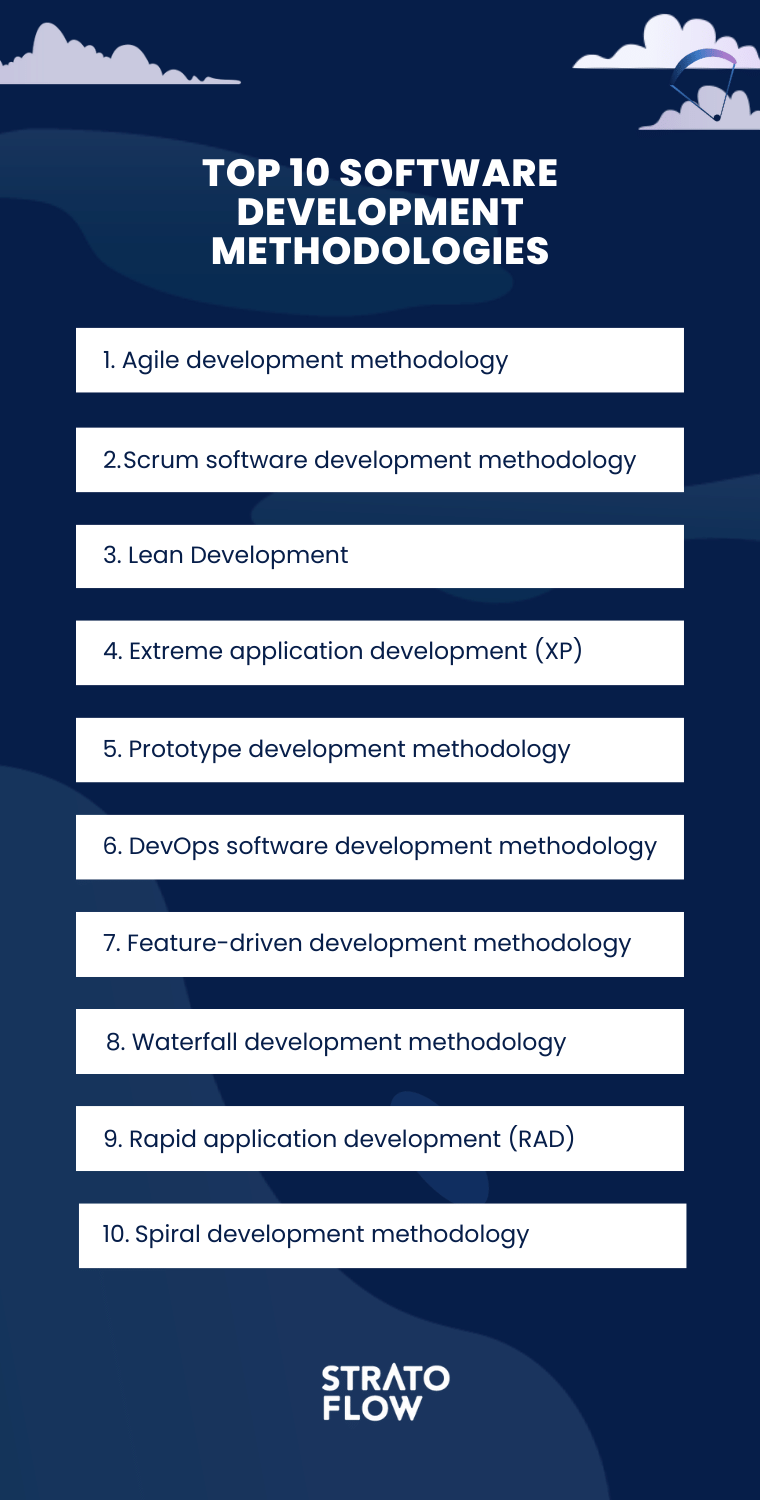
Agile development methodology
Let’s start the creme de la creme of modern custom software development projects, the approach most liked by the managers and developers alike – Agile software development methodology.
Agile stands out from other software development methodologies as the most flexible and efficient approach to software development that prioritizes collaboration, adaptability, and customer satisfaction. The general idea behind Agile is to break the software development process into smaller iterations, called sprints, in which cross-functional teams work together to deliver incremental value.
Developers like Agile because it gives them a voice in the decision-making process, encourages self-organization, and fosters a collaborative work environment.
From a management perspective, Agile provides greater visibility, transparency, and control over the entire development process, from prototyping to final release. Frequent communication and feedback loops ensure that the project stays on track and aligned with business goals.
Agile is currently so popular that it has spawned a group of methodologies that aim to improve on the concept while maintaining the general rules and concepts behind the agile approach. We will cover them in the later points.
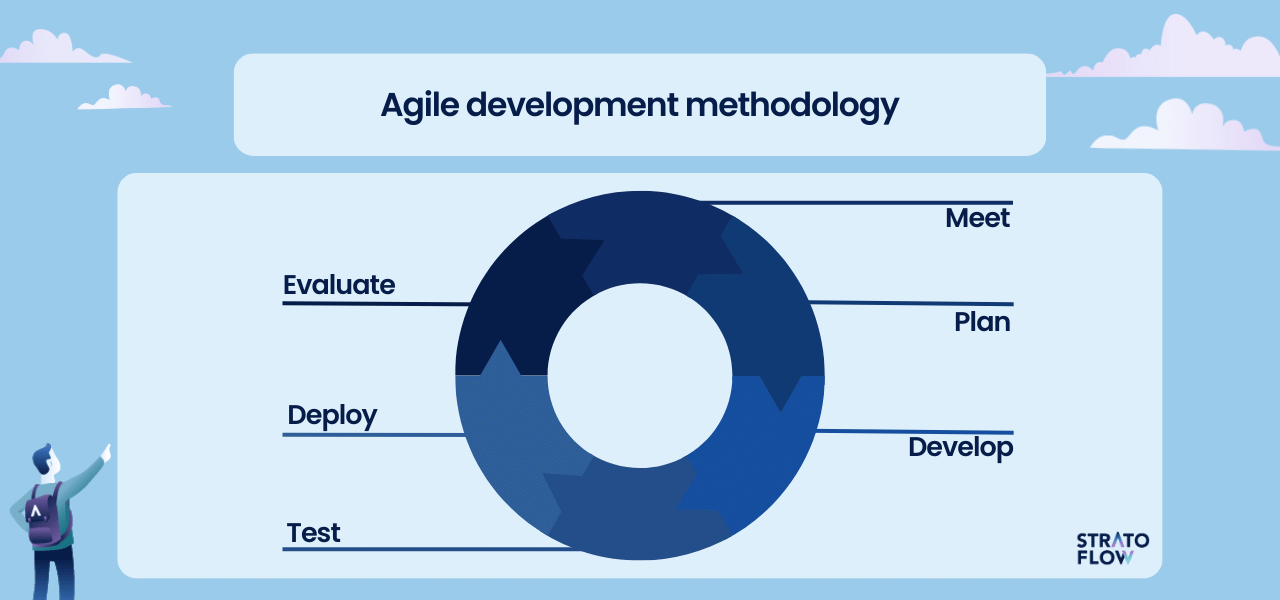
Pros
- Flexibility and Adaptability – Agile methodology allows for flexibility in responding to changing requirements and customer needs. It embraces an iterative approach, enabling teams to adapt and adjust their direction based on feedback and evolving priorities.
- Customer Satisfaction – Customer collaboration and delivering value is the main goal of Agile. By involving customers throughout the development process and continuously seeking their feedback, Agile ensures that the end product aligns closely with their expectations, resulting in higher customer satisfaction.
- Early and Continuous Delivery – Agile methodology emphasizes delivering working software in short iterations. This allows for early and continuous delivery of tangible results, providing stakeholders with visibility and the opportunity to provide feedback and make necessary adjustments early in the development cycle.
- Transparency and Collaboration – Agile also promotes transparency, communication, and collaboration among team members and stakeholders. Regular meetings, such as daily stand-ups and sprint reviews, foster open communication, allowing for better coordination, shared understanding, and collective decision-making.
Cons
- Dependency on Customer Availability – Reliance on active customer involvement and timely feedback can sometimes be problematic. If customers are not readily available or have limited availability, it can hinder the smooth progress of the project and decision-making processes.
- Team Dependency and Skill Requirements – Agile methodologies require close collaboration and self-organizing teams. It is essential to have skilled team members who can work effectively together, communicate well, and embrace the Agile mindset.
Best for
Agile software development methodology works best in a variety of business scenarios that prioritize flexibility, adaptability, and customer collaboration. It is particularly effective in projects and enterprise software with evolving requirements, dynamic market conditions, and the need for rapid software delivery.
Scrum software development methodology
The Scrum development methodology is a popular and widely used agile framework for software development. It incorporates the core principles of agile methodology while providing a specific structure for managing complex projects.
The general idea behind Scrum is to deliver value incrementally through short, time-bound iterations called sprints. It emphasizes collaboration, transparency, and adaptability. Scrum teams consist of cross-functional members who work together to deliver a potentially shippable product increment at the end of each sprint.
The Scrum framework includes defined roles (such as product owner, scrum master, and development team), ceremonies (such as daily stand-ups and sprint reviews), and artifacts (such as the product backlog and sprint backlog) to facilitate effective communication and progress tracking.
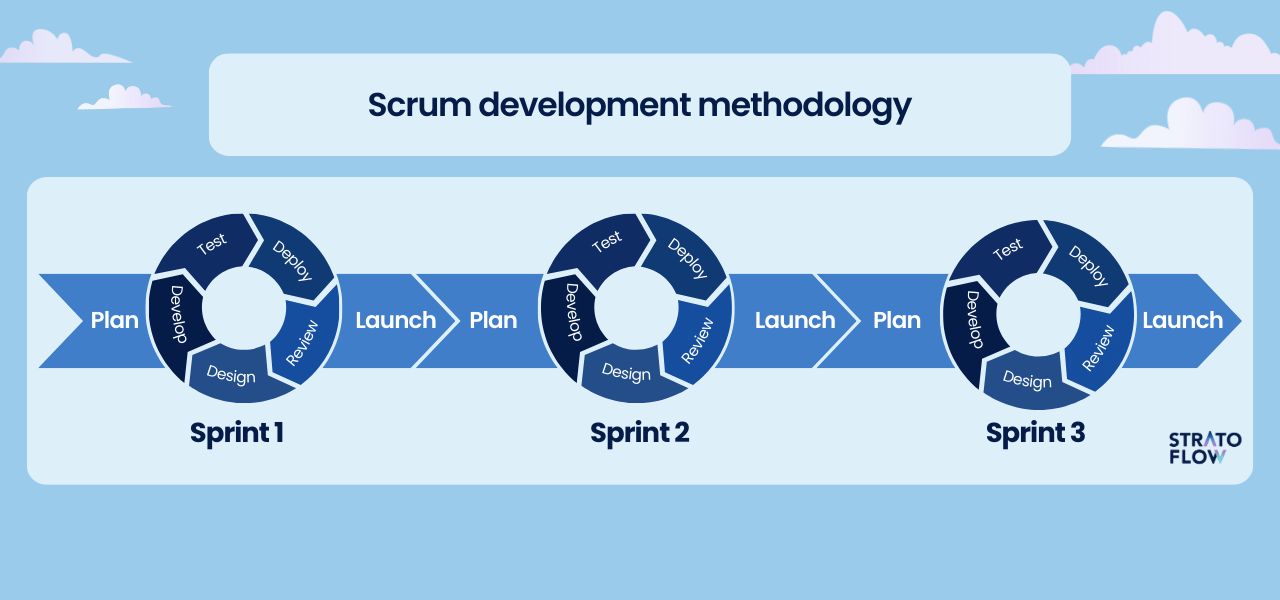
Pros
- Flexibility and adaptability – Scrum’s iterative and incremental approach allows teams to respond to changing requirements and priorities effectively. It offers the flexibility to adjust project scope and direction based on customer feedback and evolving business needs.
- Transparency and visibility – This agile framework provides transparency through its defined meetings, calls, and artifacts. Daily Stand-ups, Sprint Reviews, and Sprint Retrospectives enable clear communication, progress tracking, and accountability among team members and stakeholders.
- Continuous improvement – Scrum fosters a culture of continuous improvement through regular inspection and adaptation. Sprint Retrospectives allow teams to reflect on their processes, identify areas for improvement, and make necessary adjustments to enhance productivity and quality.
Cons
- Dependency on team self-organization – Scrum relies heavily on self-organizing teams to make decisions and manage their work. If team members lack the necessary skills, experience, or discipline, it can impact the success of the methodology.
- Learning curve – Implementing Scrum requires a learning curve, especially for teams new to Agile methodologies.
[Read more: Java Clean Code: How to Write It? Best Practices From Experts]
Best for
The Scrum methodology works best for any project where the agile approach can be applied. This means that it is well suited for various business scenarios and projects that require flexibility, iterative development, and close collaboration. Whenever the project requirements are somewhat uncertain and the scope of the project is subject to change, the Scrum software development methodology proves to be highly effective.
Extreme programming application development (XP)
Extreme Programming (XP) can sometimes be considered a subtype of agile software development, which also emphasizes collaboration, adaptability, and high-quality code. What sets the Extreme Programming approach apart is its focus on delivering value to customers as quickly and continuously as possible through small, frequent releases.
Similar to Agile, it advocates iterative development, where requirements are gathered, prioritized, and implemented in short cycles called iterations. XP emphasizes practices such as test-driven development, continuous integration, pair programming, and frequent customer feedback. These practices are designed to ensure that the software is thoroughly tested, well designed, and meets the evolving needs of the customer.
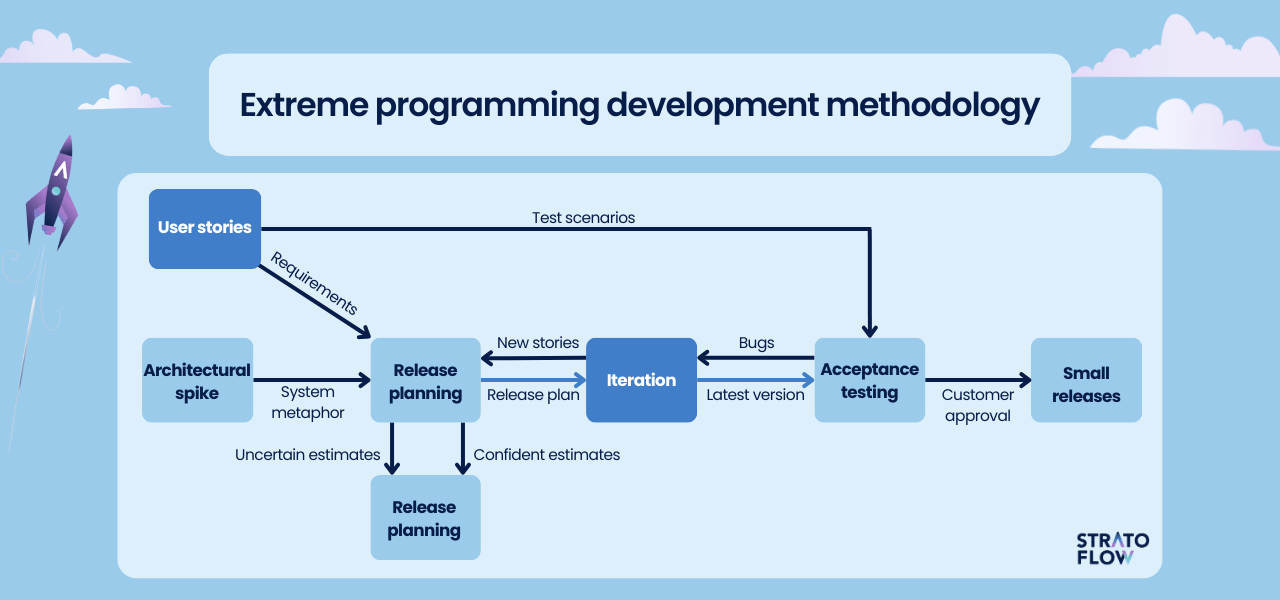
Pros
- Quality assurance – The key aspect that differentiates Extreme Programming is the incorporation of practices such as test-driven development and continuous integration, ensuring that the software is thoroughly tested and defects are identified early. This results in higher-quality code and reduces the likelihood of major issues in the final product.
- Collaboration and teamwork – XP encourages close collaboration among team members through practices like pair programming. This fosters knowledge sharing, effective problem-solving, and a sense of collective ownership, leading to improved team dynamics and productivity.
- Continuous delivery – Just like Agile, XP promotes frequent and small releases, allowing for continuous delivery of value to customers.
Cons
- Potential for scope creep – The flexible nature of XP can lead to scope creep if requirements are not effectively managed. Without proper control, there is a risk of expanding the scope beyond the initial plan, impacting project timelines and resources.
- Team size limitations – XP practices like pair programming may not be suitable for all team sizes or project contexts. Larger teams or distributed teams may find it challenging to implement certain XP practices effectively.
Best for
Similarly to Agile and Scrum, Extreme programming application development is best suited for software projects in which the requirements are expected to change frequently due to evolving business needs and market trends such as e-commerce or startup environments.
[Read more: 21 Types of Software Testing Every Engineer Should Be Using for Better Results]
Lean Development
While on the topic of subtypes of Agile, we should also cover the Lean software development methodology.
The core principle behind the Lean approach is to focus on maximizing customer value while minimizing waste. It is inspired by the lean manufacturing principles pioneered and successfully implemented by Toyota. Lean Development aims to continuously improve the development process by eliminating non-value-added activities, reducing inefficiencies, and focusing on delivering value to the customer.
In many ways, Lean Development is similar to the Agile methodology. Both approaches emphasize customer value, adaptability, and continuous improvement. They embrace iterative development, frequent feedback, and close collaboration among team members.
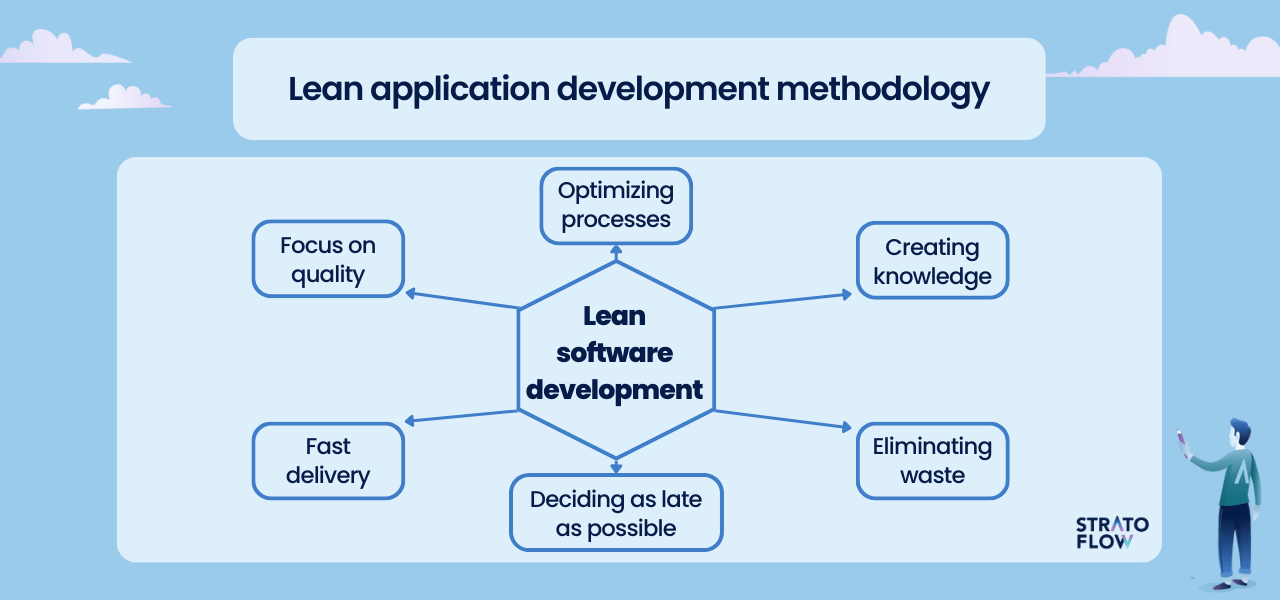
Pros
- Waste reduction – The key aspect of Lean Software Development is the elimination of waste and inefficiencies in the development process. By streamlining workflows, identifying and eliminating non-value-adding activities, and optimizing resource utilization, teams can increase efficiency and reduce unnecessary costs.
- Customer value focus – Just like other modern methodologies Lean Software Development places a strong emphasis on delivering customer value. By continuously prioritizing features and activities that add value, teams can ensure that the end product aligns closely with customer needs and expectations.
- Continuous improvement – The Lean methodology promotes a culture of continuous improvement. Teams regularly reflect on their processes, gather feedback, and make iterative adjustments to enhance productivity and quality.
Cons
- Limited documentation – Lean Software Development prioritizes delivering working software over extensive documentation. While this allows for faster delivery, it may pose challenges for teams that require comprehensive software documentation for compliance or knowledge-sharing purposes.
- Risk management – In some cases the Lean Software Development approach may not provide explicit guidance on risk management compared to some other methodologies.
Best for
Lean software development can help startups build and launch minimum viable products quickly. By prioritizing features based on customer value, eliminating waste, and continuously iterating based on user feedback, startups can efficiently deliver a Minimum Viable Product (MVP) and POC that meets core customer needs while conserving resources. Because the main idea behind Lean is continuous improvement, this approach to software development is also appropriate for established organizations looking to improve and optimize their existing legacy software.
DevOps software development methodology
When it comes to other modern options, we must also cover the DevOps development methodology, which has gained considerable popularity in recent years.
It combines software development (Dev) and IT operations (Ops) to foster collaboration and streamline the software delivery process. The general idea behind DevOps is to bridge the gap between development and operations teams by promoting cross-functional collaboration, automation, and continuous system integration and delivery. Unlike traditional methodologies, which often have separate development and operations phases, DevOps focuses on creating a culture of shared responsibility and continuous improvement.
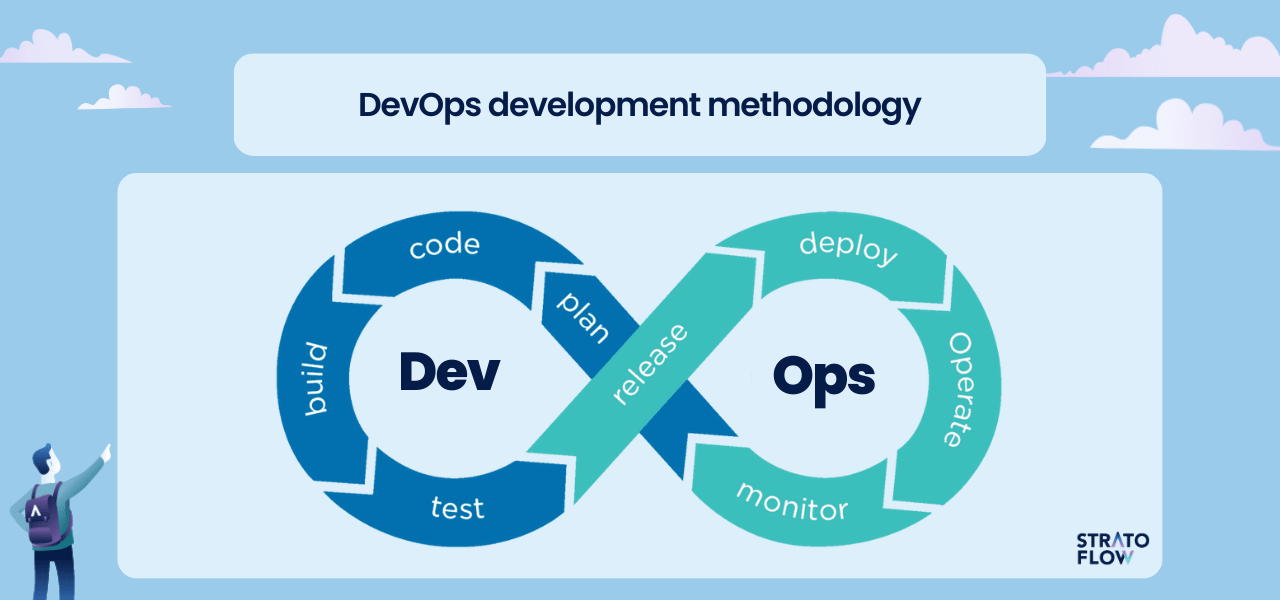
Pros
- Collaboration between developers and operations teams – DevOps fosters collaboration and communication between development, operations, and other teams involved in the software delivery process. This leads to better alignment, improved understanding, and increased efficiency through shared goals and responsibilities.
- Continuous integration and delivery – Just like other modern methodologies it also promotes continuous integration and delivery practices, allowing for faster and more frequent releases. Automation tools and streamlined processes enable teams to deliver software updates and enhancements rapidly, leading to faster time-to-market and enhanced customer satisfaction.
- Improved Quality and Stability – By integrating development and operations, DevOps emphasizes the importance of testing, monitoring, and feedback loops throughout the software lifecycle.
Cons
- Tooling and Infrastructure Complexity – DevOps heavily relies on automation, infrastructure management, and tooling. Implementing and managing these tools and infrastructure can introduce complexities and require ongoing maintenance and updates.
- Security and Compliance Challenges – With the increased focus on automation and frequent releases, ensuring security and compliance can pose challenges. DevOps teams need to implement robust security measures and ensure compliance with regulations and standards.
Best for
Organizations that operate high-traffic web applications, such as e-commerce platforms or social media networks, benefit greatly from the DevOps approach because it can help optimize application performance, scalability, and availability by ensuring continuous monitoring, proactive problem detection, and rapid incident response. DevOps is also highly effective in managing cloud-based infrastructure, including scalable applications and microservices architectures.
[Read more: Unlocking the Power of Data: A Comprehensive Guide to Database Management Systems]
Prototype development methodology
Since we’ve covered what’s currently hot the software engineering market, let’s see just how we get here, and cover some of the older methodologies that are the foundation of modern approaches the first one being prototype development methodology – a direct precursor to the modern agile and iterative development approach.
Its main focus was taking direct feedback from stakeholders and users, and permanently integrating it into the software development lifecycle. The prototype development methodology offers the concept of creating a working model, or prototype, of a software product prior to full-scale development.
The general concept behind this methodology is fairly straightforward – it involves building a simplified version of the software, such as a minimum viable product, often with limited functionality, that allows stakeholders to visualize and interact with the product. This methodology is particularly effective in scenarios where requirements are not well defined or need further clarification, and where stakeholders want a tangible representation of the software early in the development process.
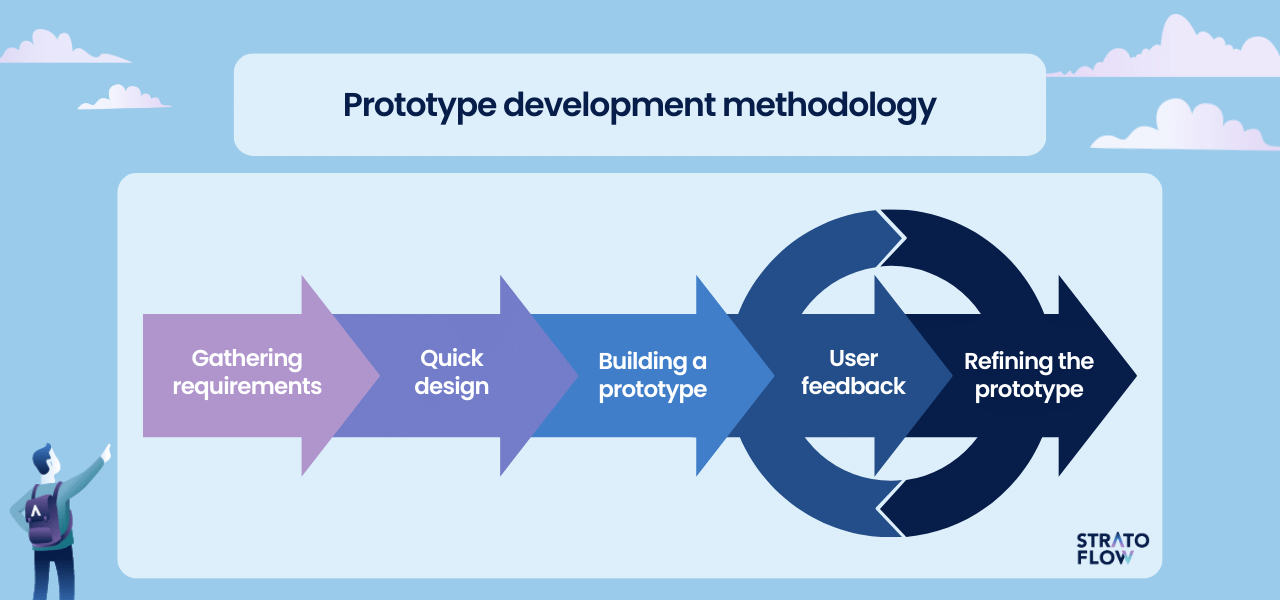
Pros
- Early feedback and stakeholder involvement – Prototyping allows for early user involvement and feedback, providing stakeholders with a tangible representation of the software. This helps in identifying requirements, clarifying expectations, and incorporating changes early in the development process.
- Improved communication and collaboration – Prototypes serve as a communication tool between stakeholders, designers, and developers. By visually representing the software, it bridges the gap between technical and non-technical stakeholders, enhancing collaboration and ensuring a shared understanding of the desired end product.
- Cost and time savings – By addressing requirements and design issues in the prototyping stage, the overall development time and costs can be reduced.
Cons
- Limited functionality – Prototypes often have limited functionality compared to the final software product. This may lead to misunderstandings or expectations of features that cannot be implemented in the final product.
- Architectural design issues – if you planning to expand your software application upon working MVP you might encounter some problems in software development later if certain decisions at the beginning stages of the development process weren’t made with scalability and expandability in mind.
- Potential scope creep – Without proper control and management, the iterative nature of prototyping can lead to scope creep. Continuous feedback and iterations may result in expanding the scope beyond the initial plan, potentially impacting project timelines and resources.
Best for
Prototyping is currently commonly used in user interface design, general product development, and iterative projects where frequent feedback and adjustments are crucial for success.
Feature-driven development methodology (FDD)
Feature-driven development (FDD) is another fairly old methodology that focuses on delivering features incrementally and efficiently. FDD gained attention in the early 2000s as one of the evolutionary steps in the progression of more modern software development methodologies.
The concept behind this approach revolves around breaking down the development process into manageable feature sets, prioritizing them, and delivering them iteratively. FDD follows a five-step process: develop an overall model, create a feature list, plan by feature, design by functionality, and build. This methodology emphasizes collaboration, domain modeling, and feature-centric development. Today, it is not as popular as some other methodologies, but it acts as a foundation for most popular development approaches such as Agile or Scrum.
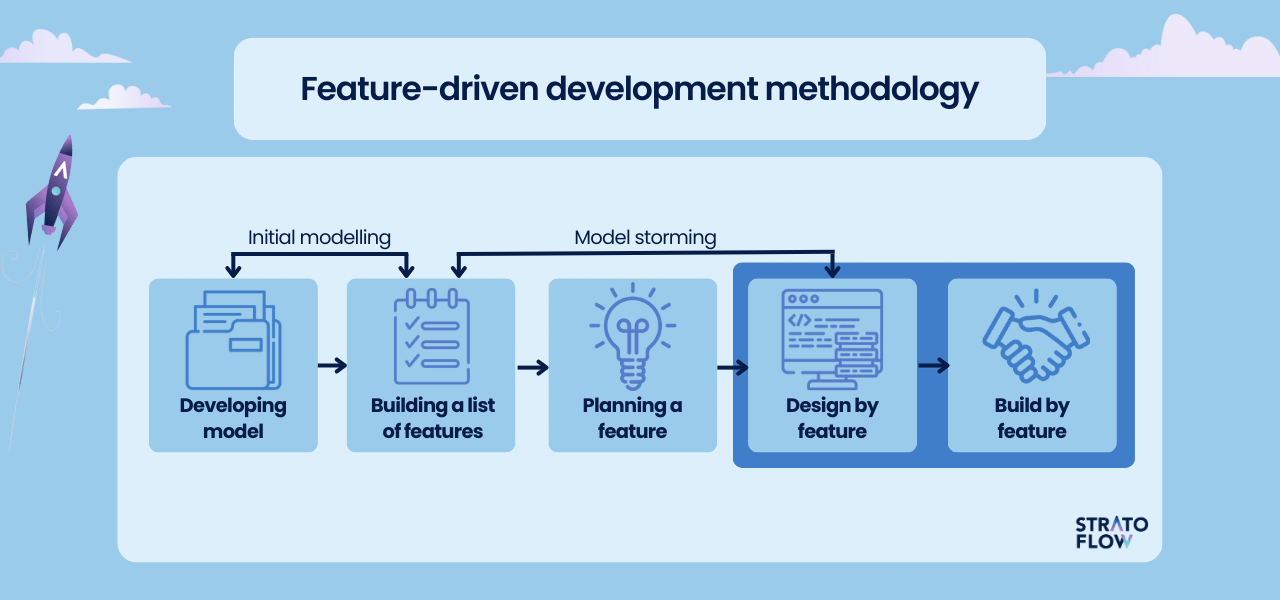
Pros
- Focus on features – FDD places a strong emphasis on delivering features incrementally, which helps ensure that software development efforts align closely with customer needs and business goals.
- Effective project planning – FDD’s step-by-step process, including domain modeling, feature lists, and planning by feature, provides a structured framework for project planning which can greatly help teams with gaining a clear understanding of project scope, and task prioritization.
Cons
- Requirement gathering challenges – FDD relies on having well-defined and understood requirements which is a rarity in today’s high-paced digital environment.
- Documentation overhead – It relies on comprehensive documentation, such as feature lists and development plans. This can introduce additional overhead, especially in projects where documentation maintenance and updates are resource-intensive.
Waterfall development methodology
Last but not least we should briefly cover true legacy software development methodologies starting with the oldest of them all – the classic waterfall approach.
Its core principle is simple: each phase of the development process must be completed before moving on to the next. Just as water flows downhill, this methodology follows a top-down progression, starting with requirements gathering, followed by design, implementation, testing, and finally deployment.
This rigid structure is designed to ensure that all aspects of the software are thoroughly planned and documented before execution. While waterfall may seem simple, its strength lies in its emphasis on careful planning and documentation.
However, in today’s rapidly evolving and dynamic business environment, the waterfall methodology is becoming less popular due to its limited flexibility, which has become much more important. Modern software development projects often require frequent iterations, adaptability to changing requirements, and the ability to incorporate early feedback, and in these scenarios, the waterfall model is simply not appropriate.
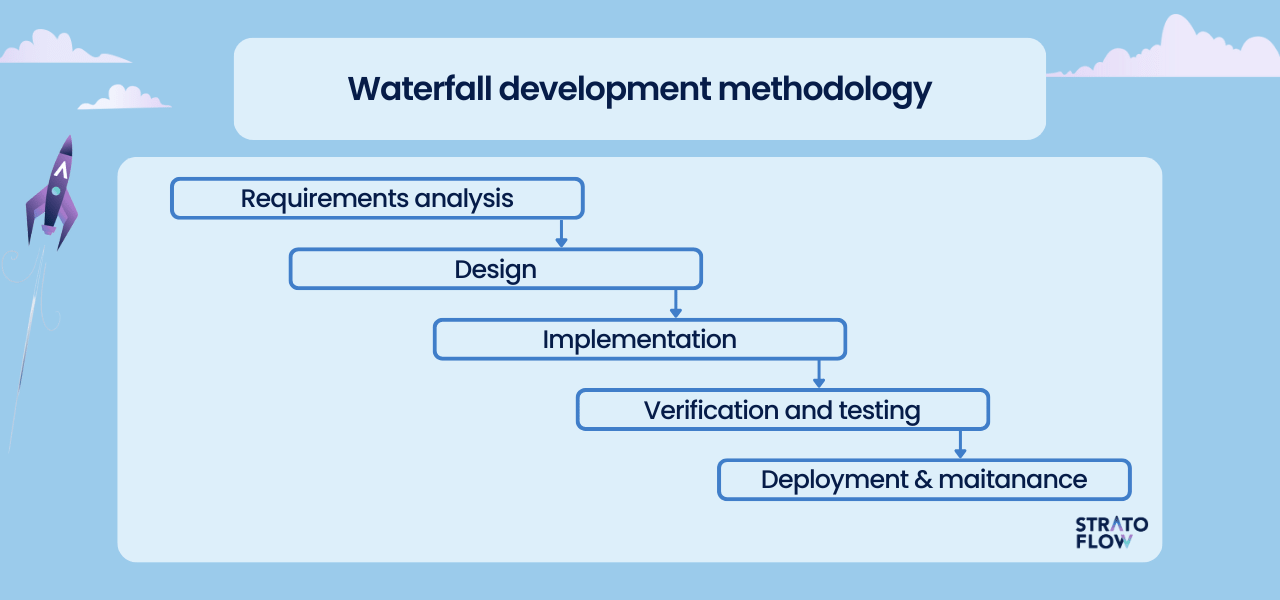
Pros
- Clear structure – The waterfall methodology provides a well-defined structure and sequential flow, making it easy to understand and follow for both development teams as well as stakeholders.
- Thorough documentation – Each phase of the waterfall model requires extensive documentation, ensuring that all requirements, designs, and project plans are clearly defined and documented.
- Early detection of issues – Since each phase must be completed before moving on, it allows for early identification and resolution of issues, reducing the likelihood of major problems surfacing during later stages.
Cons
- Limited flexibility – The linear nature of the waterfall methodology makes it less adaptable to changes or evolving requirements. Once a phase is completed, it becomes challenging to incorporate changes without revisiting earlier stages.
- Late customer feedback – Stakeholder and user feedback in the waterfall model typically come late in the development process, often during the testing or deployment phase. This can lead to misunderstandings or a lack of alignment with client expectations until the final stages.
- Risk of incorrect assumptions – Due to the upfront nature of the waterfall development methodology, there is a risk of making incorrect assumptions or overlooking crucial requirements during the early stages, which can lead to costly rework or unsatisfactory outcomes.
Rapid application development (RAD)
The Rapid application development (RAD) methodology revolves around the idea of accelerated development cycles and rapid delivery of functional software.
Its main goal is to prioritize speed and responsiveness to changing requirements while maintaining a high level of quality. Unlike traditional waterfall methodology, RAD focuses on iterative development, where software is built in small, incremental steps which is much more similar to what we have today. As a result, unlike its predecessor, this approach allows for early and frequent feedback from users, ensuring that the software effectively meets their needs.
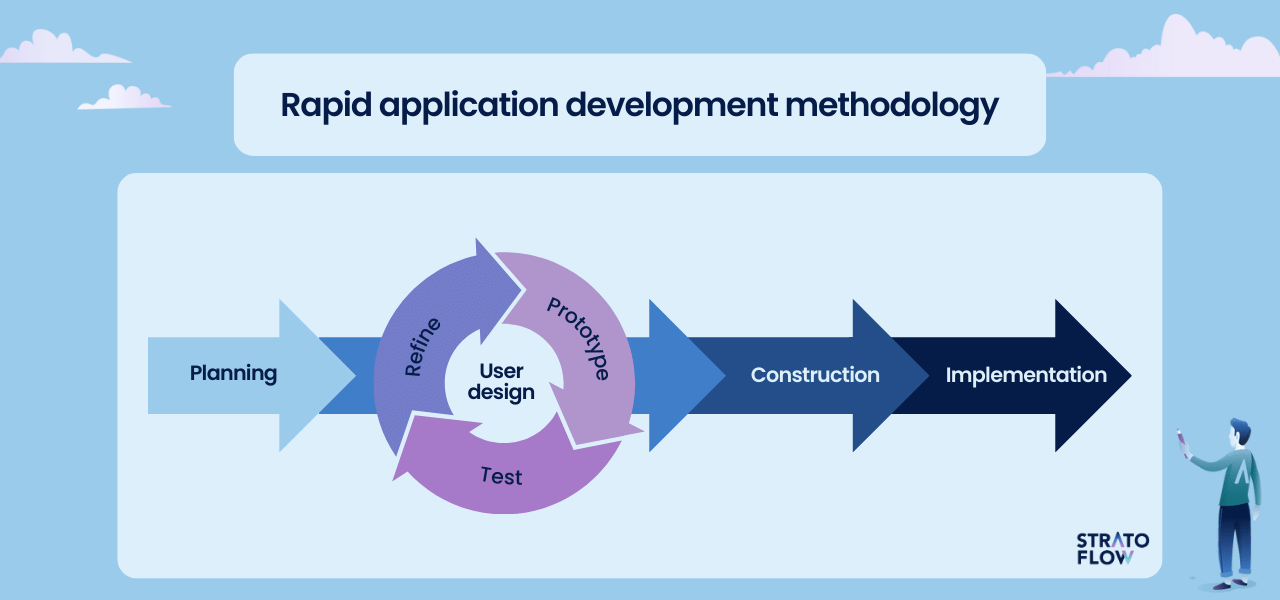
Pros
- Faster development cycles – RAD emphasizes quick iterations and rapid prototyping, enabling faster delivery of functional software. This can be beneficial for projects with time-sensitive requirements or those aiming for a speedy time-to-market.
- Increased customer involvement – RAD was the first to encourage frequent customer feedback and involvement throughout the development process which has become a standard for modern development projects.
- Flexibility and adaptability – RAD embraces changes and allows for flexibility in accommodating evolving requirements. It enables teams to respond quickly to feedback, incorporate modifications, and make necessary adjustments during the development cycle.
Cons
- Potential for scope creep – The flexibility of rapid application development can sometimes be a double-edged sword. Without proper control and project management, frequent changes and iterations can lead to scope creep, where the project quickly expands beyond the original boundaries.
- Reliance on skilled team members – RAD relies heavily on a highly skilled and cohesive development team. It requires expertise in rapid prototyping, efficient communication, and close collaboration. A lack of experienced team members can hinder the success of RAD projects.
- Compatibility challenges – Rapid iterations in RAD may in some cases introduce compatibility issues with existing systems or technologies. Integration and compatibility testing become crucial to ensure seamless interoperability with other components or systems.
Spiral development methodology
Finally, on the last spot of our list, let’s mention the Spiral software development methodology, which is an iterative approach that combines elements of both waterfall and iterative RAD development models.
It follows a risk-driven approach where the development process is organized into a series of spirals, each representing a complete iteration. The concept behind the Spiral methodology is to address risk early in the project lifecycle.
Software projects using the Spiral methodology begin with the identification of goals and requirements, followed by risk analysis and assessment. Then the subsequent spirals begin, which include prototyping, development, testing, and customer evaluation. Like RAD, the spiral methodology emphasizes constant feedback and risk management, allowing for flexibility and adaptation as the project progresses.
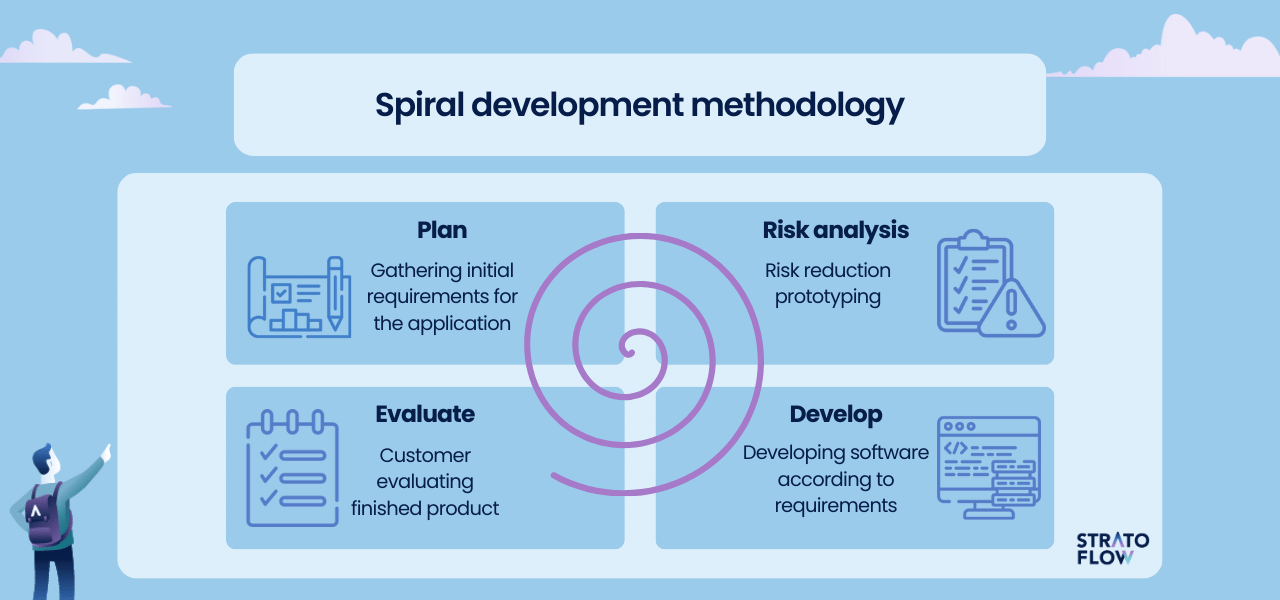
Pros
- Risk management – The Spiral methodology places a strong emphasis on identifying and mitigating risks early in the project lifecycle. This allows teams to address potential issues proactively, reducing the chances of major setbacks later on.
- Flexibility and adaptability – The iterative nature of the Spiral methodology provides flexibility to accommodate changes and evolving requirements. Each spiral allows for adjustments based on customer feedback, ensuring that the final product aligns closely with user expectations.
- Customer involvement – The Spiral methodology encourages regular customer involvement and feedback throughout the development process.
Cons
- Complexity – The Spiral methodology can be more complex to implement compared to linear methodologies as it requires a thorough understanding of risk assessment, iterative development, and customer involvement.
- Cost considerations – The Spiral methodology can be more expensive compared to other linear methodologies, particularly if the project requires numerous iterations and extensive prototyping. Adequate budgeting and cost management are essential to prevent cost overruns.
Our approach
At Stratoflow, we strive to provide our customers with the highest quality software solutions with excellent performance and scalability in mind. That is why our internal process combines the key elements of the Agile and Scrum methodologies, allowing us to collaborate effectively and create a creative and productive working environment.
In software projects, we value flexible approaches, prioritization, iterative delivery, and short development cycles that allow our customers to play an active role in the entire process.
We believe that open communication and regular feedback should be a top priority to minimize the risks associated with software projects. That’s why our developers are always vocal about any ideas or problems, and we value critical opinions and mutual trust.
A custom software system should fit your business like a tailored suit – perfectly crafted, with fabric and cut carefully chosen with the highest standards in mind. This is the main reason why our approach is based on a flexible approach, prioritization, iterative deliveries, and short development cycles to deliver the best value in the shortest time, always with the specific business needs of each client in mind.
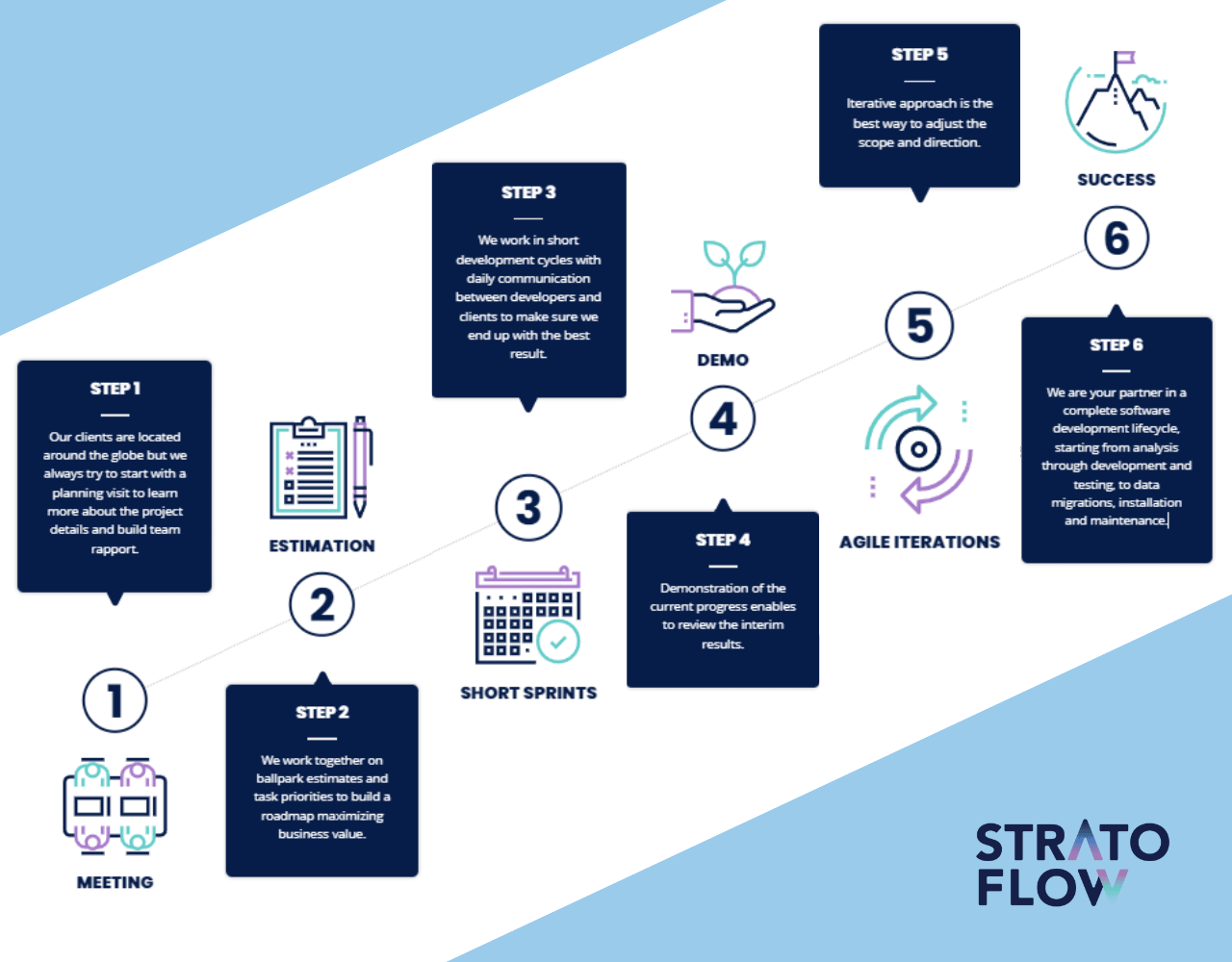
Conclusion
As the software development landscape continues to evolve, choosing the right methodology is essential for organizations to deliver successful software projects.
The ten methodologies highlighted in this article offer a wide range of options, each with its own unique strengths and benefits. By carefully evaluating project requirements, team dynamics, and organizational culture, organizations can make informed decisions and select the methodology that best fits their specific needs.
Regardless of the final choice, the right software development methodology will enable organizations to drive innovation, increase productivity, and deliver exceptional software solutions in an ever-changing digital world.
Related Posts
- How to Build an Inventory Management System: Key Steps and Tips
- How to Build a Document Management System: Alternative Approach
- Online Shopping Recommendations – Introducing Them to Your Business
- Amazon Product Recommendation System: How Does Amazon Algorithm Work?
- Movie Recommendation Systems: A Business Guide
Thank you for taking the time to read our blog post!